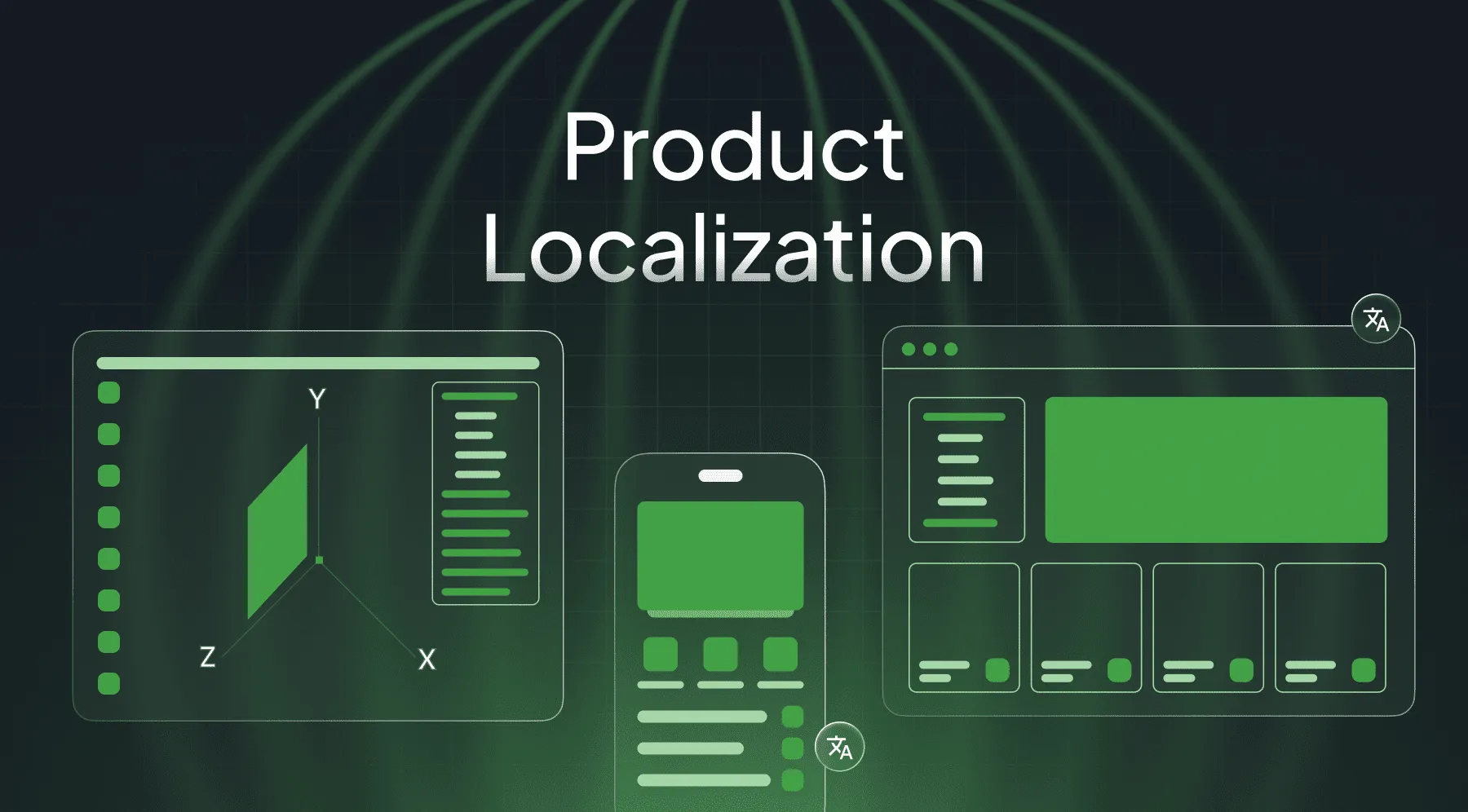Did you know that 76% of global consumers prefer to buy products that provide information in their native language, according to CSA Research? Brands seeking to expand globally should keep this in mind.
While many companies still believe an English version or simple translation is enough, the reality is different. A single-language product is invisible to the majority of the world’s users. You must localize your product for each target market.
Product localization requires a clear, strategic plan that combines:
- technical readiness
- cultural intelligence
- workflow automation with AI localization tools
We’ll walk you through the step-by-step process of successfully localizing digital products. The guide will help your business stand out among local competitors. We will go over statistics, examples, and strategies you can add to your work processes today.
What Is Product Localization?
Product localization is a process of adapting a product to tailor it to the culture and language of international markets. Almost 80% of the global audience is not fluent in English. This makes localization essential for reaching a broader range of potential customers.
Digital product localization includes more than the translation process. Changing visuals and altering operating systems are also a part of creating a successfully localized product. The aim is to create a product tailored for the target market. A product that resonates with local values and connects with customers on a deeper level.
Localization is an ongoing process. It involves adapting the product to:
- changes in market conditions
- preferences of target customers
An effective product localization strategy ensures that the product meets the needs of the new market, creating a more meaningful connection with consumers.
Product Localization vs Internationalization (i18n) vs Translation
The translation process focuses on converting written content into foreign languages, maintaining the original meaning. Product localization involves adapting a product to meet the cultural and contextual needs of a target market.
Key differences include:
- The main goal of translation is to convert written content into foreign languages, maintaining the original meaning (linguistic accuracy).
- Localization (l10n) manages the entire process, including user experience, visuals, and cultural relevance. Localized content must consider language differences, cultural sensitivities, legal regulations, and other preferences.
- Internationalization (i18n) is the process of designing and developing products to be adaptable to various languages and cultures before localization begins. For example, creating flexible code is key. It should allow easy future software localization for the new markets.
A product localization strategy integrates translation, internationalization, and localization. It helps to create a product that feels native to each target market.
4 Pillars of an Effective Product Localization Process
Effective product localization consists of four essential components:
- Cultural and linguistic localization
- Technical localization
- Visual and UX localization
- Compliance with legal regulations
Each component plays an important role. These pillars guarantee that the product resonates with new markets.
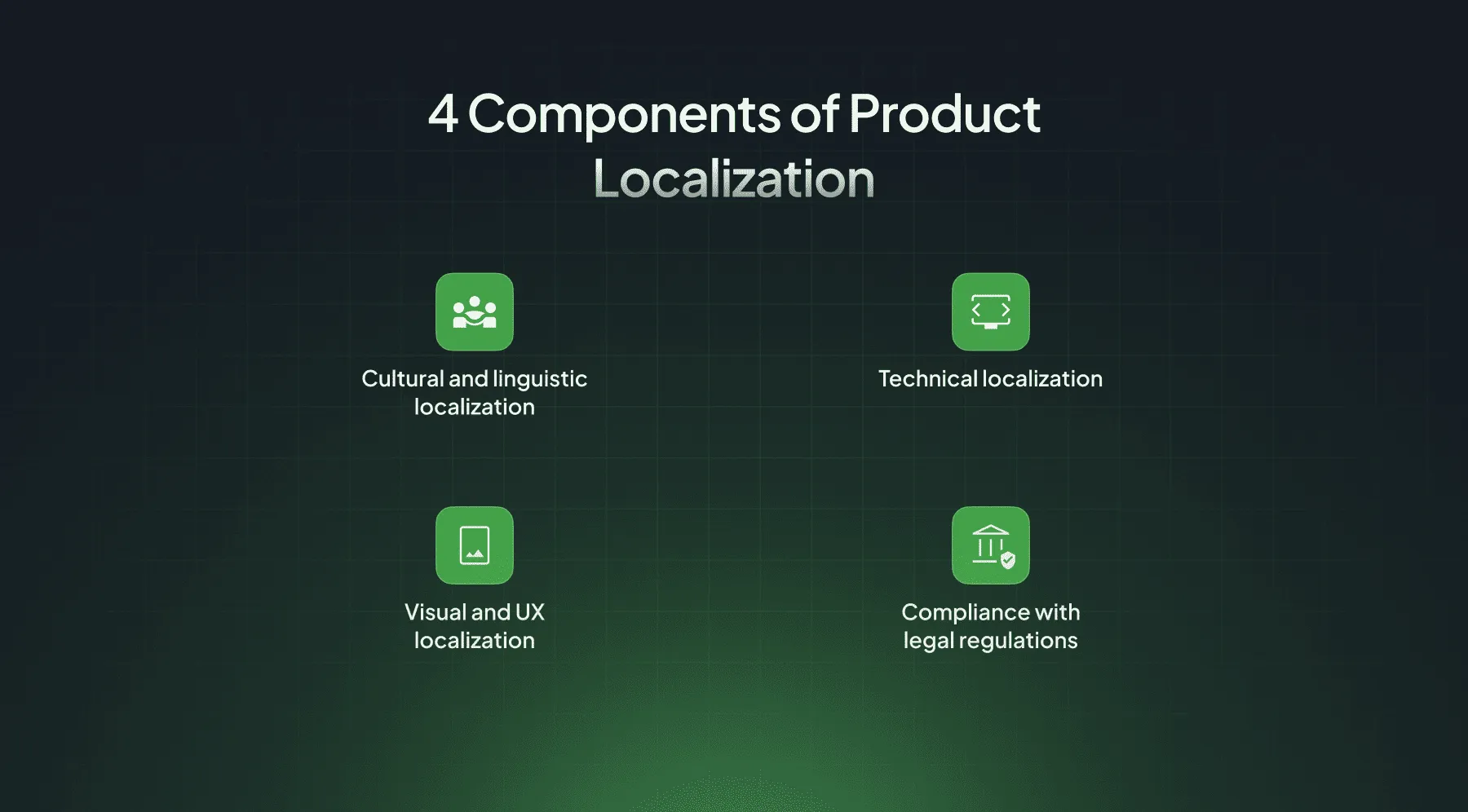
Pillar 1: Cultural and Linguistic Localization
Cultural and linguistic localization creates alignment with the local customs and norms of idioms, tone, and references.
Goal: Create a product that feels natural to the audience. Respecting cultural sensitivities and adapting expressions is vital. It helps companies prevent misunderstandings and build stronger user engagement.
Solution: Crowdin’s integrated glossaries and Agentic AI help linguists maintain the correct tone and reference established terminology, ensuring consistency across all language variants.
Pillar 2: Technical Localization and Internationalization
Technical adaptation is another vital pillar. It makes certain that the product is functionally ready for global markets.
- Internationalization requires creating flexible code that can handle text expansion (preparing layouts for 20–30% text difference), diverse character encoding, and correct formatting for dates, times, and currencies (using ISO standards).
- Crowdin Solution: Use tools like Crowdin’s CLI and integrations with GitHub, GitLab, and Azure Repos. Such tools help automate the continuous synchronization of source files and translations, eliminating manual file management for developers and ensuring technical readiness at all times.
Here are some extra important parts of technical adaptation:
- Optimizing performance to meet the bandwidth and infrastructure capabilities of different regions.
- Testing the product for functionality in various languages. It is important to identify and resolve any issues that could arise from localization.
Pillar 3: Visual and UX Localization
User interface designs must be flexible. Key considerations for designing localized UI include:
- Text expansion to make sure the product remains appealing and functional across multiple languages.
- Localizing images, colors, and icons to match cultural preferences.
- Enhancing user engagement by making the product feel more familiar and intuitive to local audiences.
Crowdin Focus: Crowdin’s design tool plugins (Figma, Sketch, Adobe XD) allow designers to test translated text directly within their mockups. In-Context Preview and Screenshot Tagging give translators the visual context they need to prevent translations from breaking the user interface.
Remember to tailor user experience design to local preferences. This adaptation also includes adjusting user flows, navigation logic, and interaction patterns to align with regional user expectations and reading norms (e.g., right-to-left languages).
Pillar 4: Legal and Regulatory Localization
Localizing products requires adherence to local laws. This pillar also includes regulations on data privacy and consumer rights. This is especially important when discussing intellectual property and advertising standards. Covering compliance with:
- Local laws
- Privacy policies (like GDPR)
- Payment methods
- Advertising standards, etc.
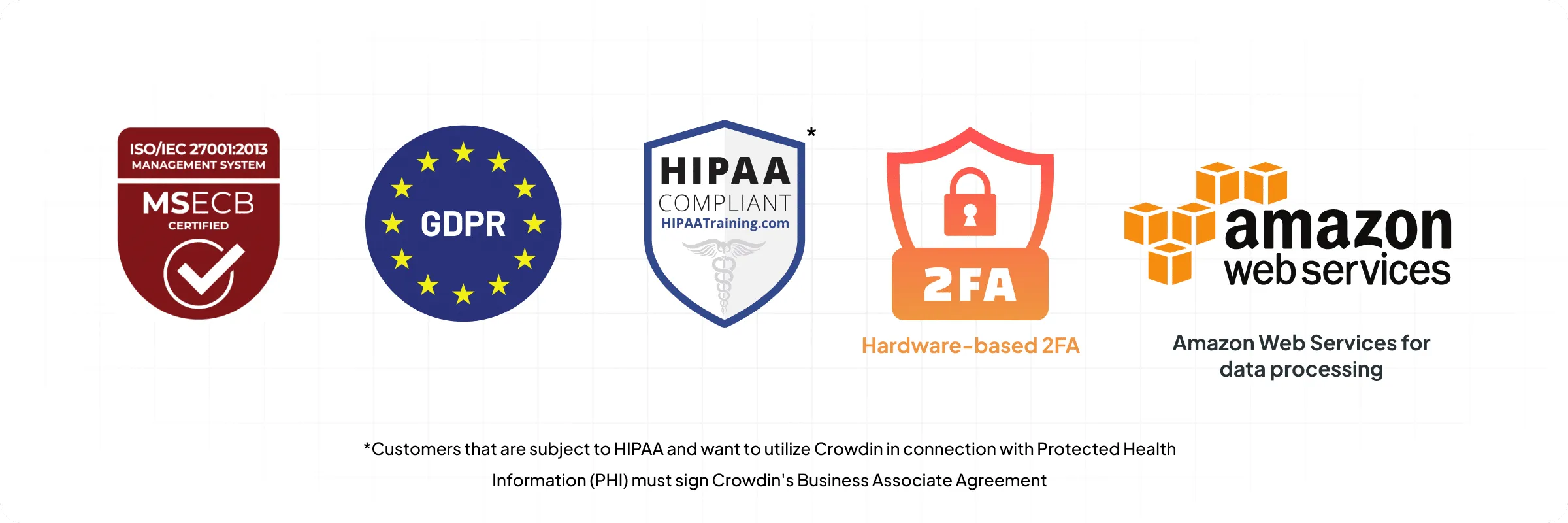
Crowdin Focus: Crowdin’s advanced security measures, including ISO/IEC 27001 certification and GDPR compliance measures (including optional EU data centers for Crowdin Enterprise users), provide a secure environment for processing sensitive localization data.
Benefits of Implementing a Product Localization Strategy
Product localization strategy helps meet diverse market requirements and improve usability for target consumers. A well-implemented localization strategy can lead to a faster market introduction. This results in greater revenue and heightened customer satisfaction.
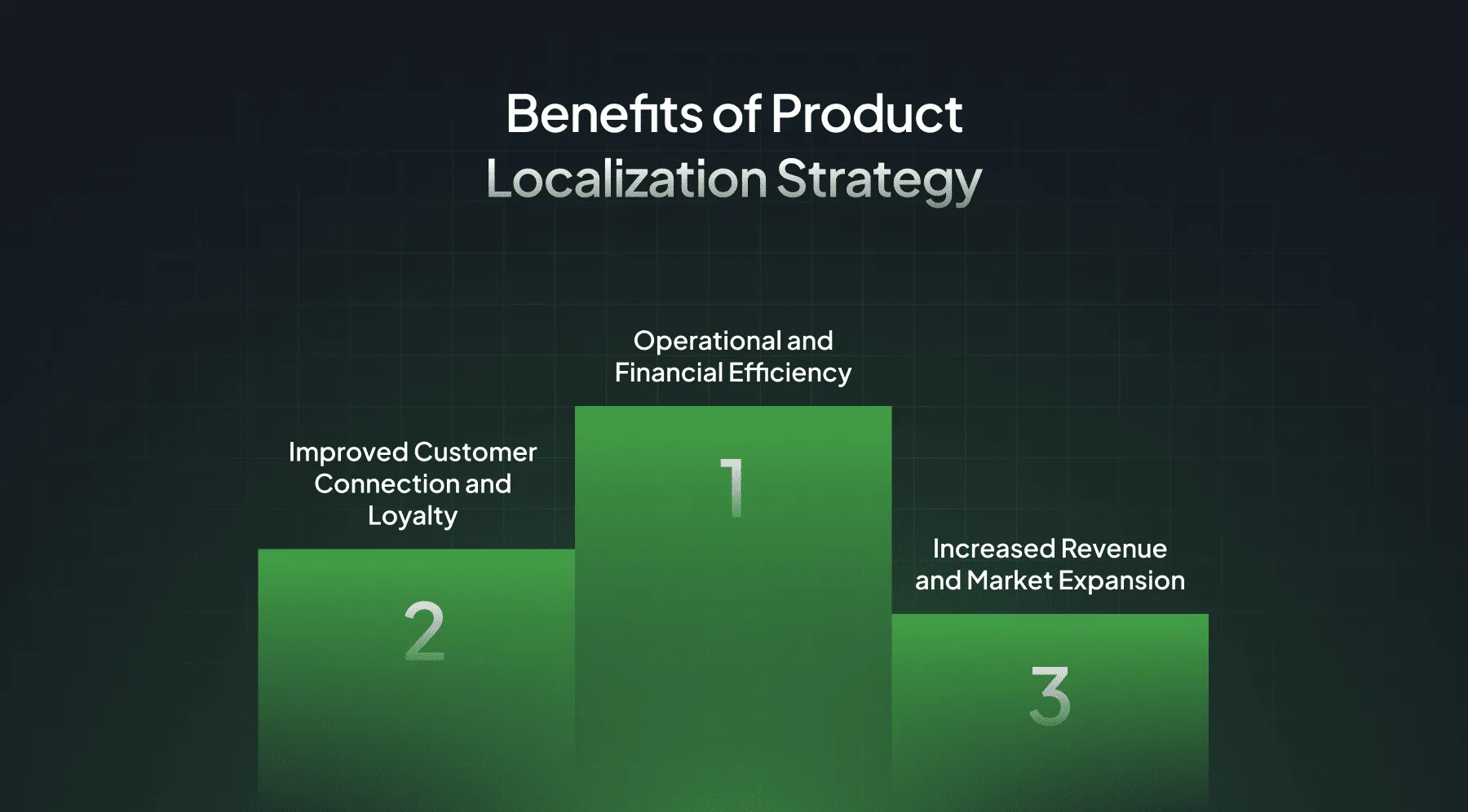
1. Removing Language and Cultural Barriers
Product localization offers several benefits:
- Removes language and cultural barriers, strengthening the connection with the customer.
- Cultural adaptation can prevent negative perceptions and increase customer acceptance of the product.
- Integrating localization early in development. It shortens the timeline for entering new markets and improves acceptance rates.
Providing multilingual customer support is key to customer retention and enhances trust. Addressing cultural differences and preferences is vital. This way, the localization strategy ensures that the product resonates with the target audience’s identity and norms. As a result, it creates a more meaningful connection with consumers.
2. Accelerating Time to Market
Build in localization early for faster product releases. Align product development processes with market needs from the start. A common mistake is to begin the localization process too late.
Early integration of product localization can reduce time to market. This allows businesses to capture new target markets in an efficient way. We’ll discuss design-stage localization later in the article.
3. Increasing Customer Base and Revenue
Product localization offers several benefits:
- Increases customer base and satisfaction across diverse regions.
- Makes products more relatable and easier for customers to understand. Result - increasing amount of sales.
- Multiplies app downloads across different regions through app localization.
- Boosts revenues by tailoring products to local standards.
By connecting localization benefits directly to core business metrics (e.g., increased revenue, reduced churn), companies can see measurable proof of its impact on global growth.
Types of Product Localization
While the principles of localization remain universal, the specifics vary depending on the type of product.
1. Software and SaaS Localization
Software and SaaS localization involves:
- Modifying user interface elements
- Ensuring compatibility with different cultural formats, like currencies and date styles
Effective SaaS localization requires adapting software products to fit the cultural, linguistic, and regulatory needs of specific markets. This process goes beyond linguistic localization.
Best practices for software localization include:
- Using separate resource files for different languages. This process helps simplify management and avoid hard-coded elements.
- Testing and quality assurance should be integrated from the start. It provides valuable insights and allows for the identification of issues early. This guarantees the final product works without any technical errors.
2. Mobile App Localization
Mobile app localization extends to:
- UI text
- Onboarding processes
- Optimizing the mobile app store presence
This process involves not only linguistic localization. Adjusting app functionalities to meet local user preferences and regulations is also essential.

Here are the key points of app localization:
- Designing with flexible text space. Different languages can vary in length, which may impact the app’s layout.
- Localizing the app store listing. Localize your keywords and app descriptions. That leads to improved visibility and discovery in new markets.
- Providing context to translators. This improves translation quality by allowing users to see how text fits within the app’s user interface.
- Automating the localization process. It can help maintain quality and speed up workflows by integrating with the app’s codebase.
3. Website and Web App Localization
Website localization focuses on creating a UX that feels tailored to new markets. The process includes:
- Language adjustments
- Layout adaptations
- Adapting content, visuals, and navigation
Effective website localization can enhance the likelihood of users making purchases by communicating in their native language.
Localizing user experience (UX) involves:
- Adapting website design elements to meet the preferences of international users.
- Testing localized websites. The process ensures that translations are accurate and that the UI functions properly for different languages.
- Automating the localization process. An all-in-one localization platform can improve operations and cut errors by integrating with various Content Management Systems.
6-Step Product Localization Workflow
The product localization process requires careful planning. An effective localization workflow involves several steps in this complex process:
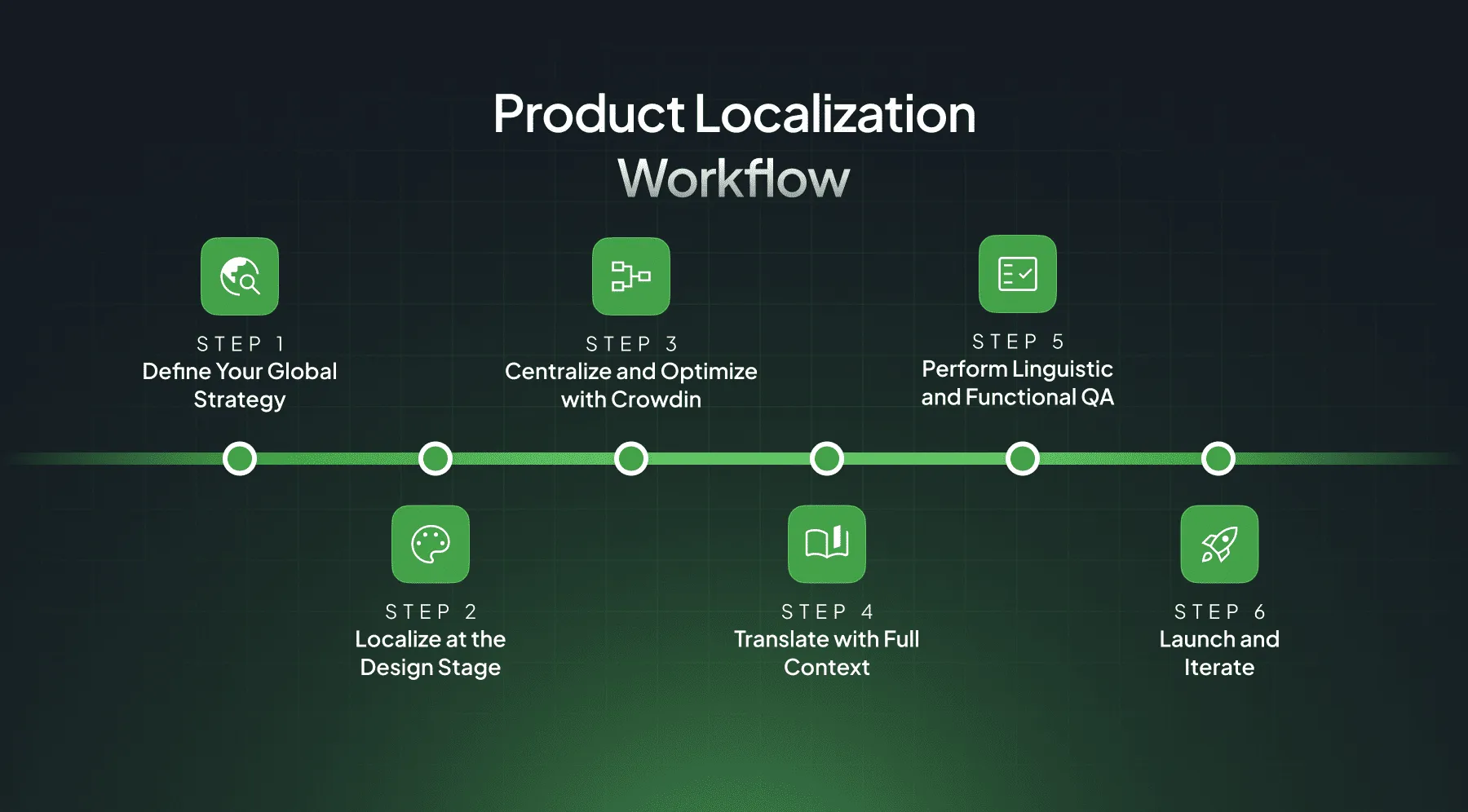
Step 1: Define Your Global Strategy and Conduct Market Research
Start by establishing a clear global market strategy:
- Identifying specific target markets. It allows them to tailor products to local preferences and regulations in the new market.
- Conducting in-depth market research. It helps identify cultural nuances and consumer behaviors essential for targeted localization.
- Understanding local competition and market dynamics. This is crucial to positioning a product in new regions.
Defining your global business strategy should be the first step in the localization process. It helps create a foundation for a localization process, adaptable to international markets.
Step 2: Localize at the Design Stage
Incorporating localization from the beginning of the design process is a must. It makes collaboration among designers, developers, and translators more effective.
Integrating localization during the design phase means translating user interfaces even before development. This way, you already get localized prototypes. Companies adopting design-stage localization can experience up to 90% faster feature rollout.
Crowdin plugins for Figma, Sketch, and Adobe XD allow designers to preview localized UI and sync content without leaving their design tool. This helps create flexible designs that are ready for foreign languages from the outset.
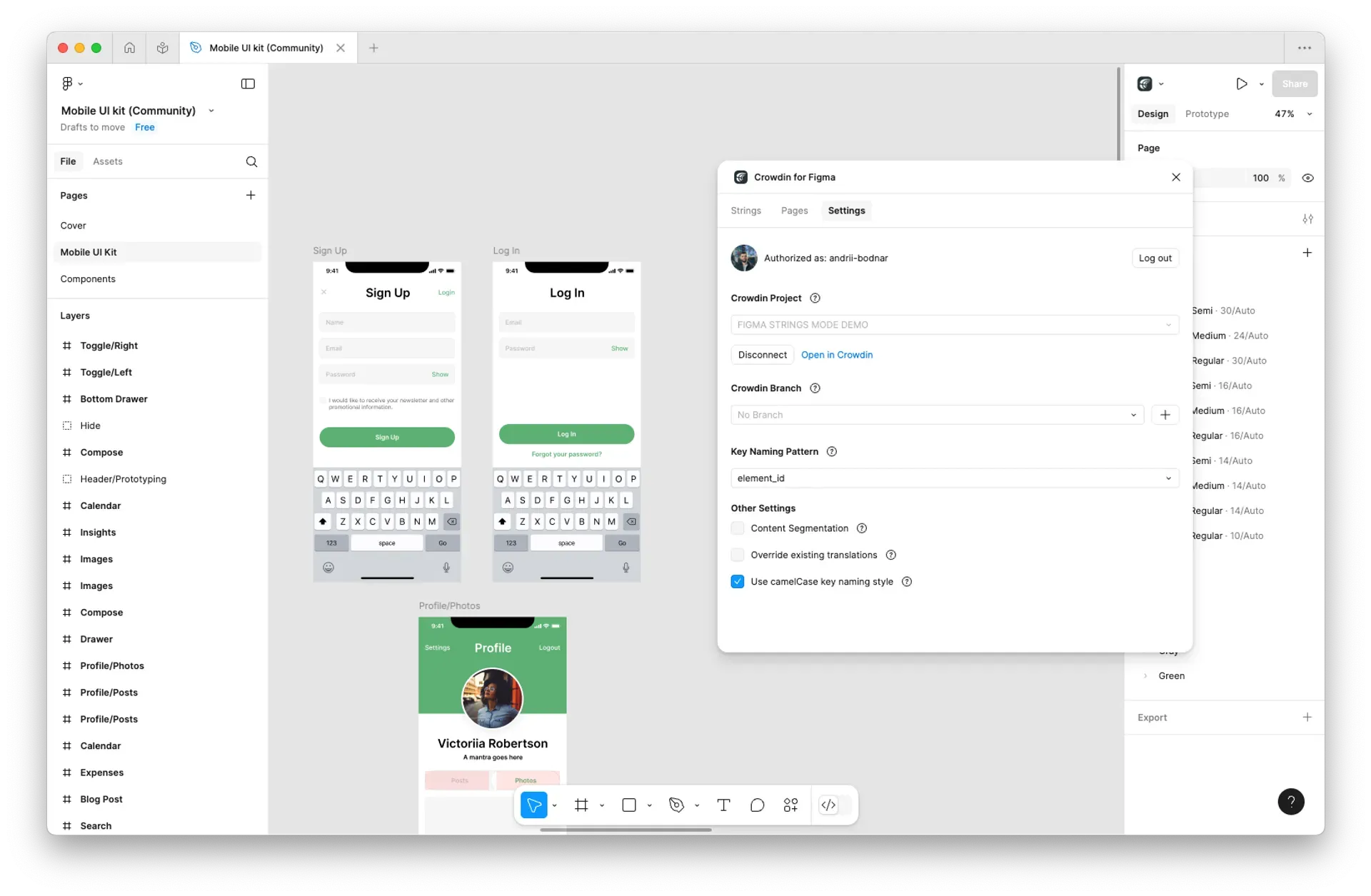
Moreover, such an approach helps prevent costly design errors by ensuring easy UI adjustments based on translated text.
Gather feedback from user testing in native languages early in the development cycle. This will also help improve the user experience.
Step 3: Centralize and Automate with a Translation Management System
A Translation Management System (TMS) provides a centralized platform for managing translations. It optimizes translation efforts by:
- Automating repetitive tasks
- Improving translation consistency
- Boosting translator productivity
Implementing a TMS like Crowdin can provide several advantages:
- It can decrease project timelines by over 50% by automating manual tasks and enabling continuous localization.
- Customizable and complex workflows help project managers efficiently set up, orchestrate, and track every stage of the translation process, including Source Text Review and QA.
- Help cut scattered communication by consolidating all localization in one platform.
Step 4: Translate with Full Context
Localization requires adjusting idioms, humor, and cultural nuances to align with local expectations and preferences. To successfully handle this complexity, translators require full context, which is where Crowdin’s advanced tools are unmatched.
You can choose from:
- In-context preview: See exactly how the text fits into the live application or website.
- Screenshot tagging: Links text strings directly to their location on product images for instant context.
- Context Harvester: Gets contextual data from your codebase to enrich strings.
- Agentic AI: Provides highly relevant, context-aware ai translation suggestions.
Choose from 10 AI providers to create a quick pre-translation draft. The translator’s job is now to review translations and focus on true product localization.
To maintain quality, Crowdin equips translators with essential review tools:
- Translation Memory (TM) & Glossaries instantly reuse approved phrases and manage official terminology across all projects.
- Use Agentic AI to do complex tasks such as adjusting the tone of voice across the entire project or automatically adapting long text strings to fit UI limits.
- In-Editor QA Checks automatically flag errors like typos or excessive text length, helping translators catch mistakes before approval.
- Real-time Collaboration lets teams leave comments directly on the string, eliminating email chains and speeding up problem-solving.
With these integrated features, translators are no longer working in the dark. This improves the quality and speed of business translations.
Step 5: Perform Linguistic and Functional Quality Assurance (QA)
Linguistic quality assurance (LQA) checks the translation’s accuracy, grammar, and cultural relevance to ensure a great user experience. Crowdin supports advanced LQA checks that automatically flag linguistic errors and adjust the project’s tone.
Functional testing validates that localized content maintains usability. Additionally, verifying that user interface elements work as intended across all languages.
Don’t forget about a well-defined style guide. It helps to maintain consistent terminology and brand voice across all translations.
Step 6: Launch the Product to a New Market and Iterate
The initial launch is just the start; successful localization is a continuous process.
- Targeted Marketing: Launch localized campaigns to introduce the product to the new market.
- Feedback & Iteration: Keep collecting user feedback after launching. This helps you refine features and verify that the product meets the local audience’s preferences.
- Continuous Localization: Use CI/CD integration to guarantee that all updates and new content are available in all target languages instantly.
Stay responsive to market changes and consumer preferences. This allows businesses to secure the long-term success of their localized products.
Extending Localization Beyond the Product
When a product speaks the local language, customers trust it more, leading to stronger loyalty. Extending localization beyond the product itself involves:
- integrating localized content with various systems
- ensuring that all customer touchpoints are relevant to the local culture
Integrating with Content Management Systems
Integrating with a Content Management System (CMS) is useful for synchronizing all multilingual web content. Crowdin acts as a central hub, providing integrations with top CMSs. These integrations help to avoid manual file transfers and guarantee that users receive consistent, up-to-date information across all languages.
CMS localization involves adapting a wide range of content, including:
- Long-Form Content: Blog posts, articles, and technical documentation.
- Website UI Elements: Headers, navigation menus, and button labels.
- Search Optimization: Page titles, meta descriptions, and image alt-text (metadata).
Effective localization requires this level of integration to maintain content quality and avoid inconsistencies across different local versions.
Localizing Marketing Materials
Adapting marketing messages is highly important for a product localization strategy. A tagline that works in one country can be meaningless in another.
To maximize your impact in a new market, focus on:
- Adaptation: Sometimes you need a new brand identity, slogan, or entire campaign to connect strongly with local consumers.
- Research: Dig deep with market research to truly understand local slang, humor, and consumer preferences.
It’s easy to manage your multilingual marketing (including all website copy, campaigns, and emails) inside Crowdin, which automatically synchronizes content with your marketing automation tools.
More applications here
Supporting Localized Customer Service
Customer service is often the critical stage for building long-term loyalty. When a user runs into a problem, providing support in their native language can be more useful.
Providing customer service in local language offers several benefits:
- Builds trust and long-term relationships with customers.
- Ensures that customers feel understood and valued.
- Speeds the resolution of the problem.
- Improves the experience with the product.
More applications here
To manage this content, Crowdin integrates with your Help Desk systems to keep all support articles, FAQs, and knowledge bases instantly localized and up-to-date.
Case Study: Ajax Systems
Security tech company Ajax Systems needed precise localization into 11+ languages.
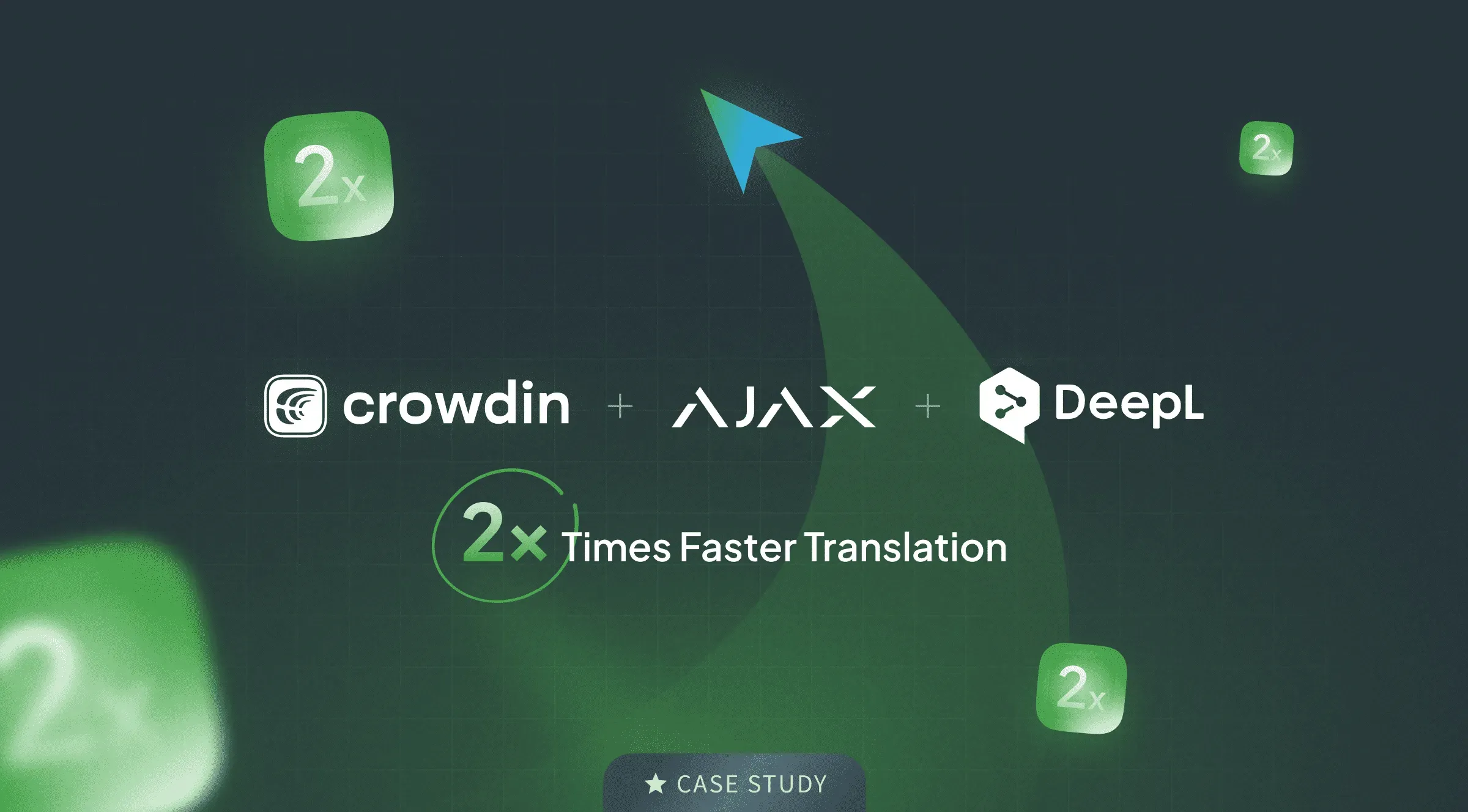
By transitioning to Crowdin Enterprise and integrating Machine Translation tools, they adopted a hybrid workflow where human editors focused only on post-editing (MTPE).
This allowed them to:
- Achieve 2 Times Faster localization turnaround.
- Cut translation expenses by 3 Times.
This case demonstrates that combining Crowdin’s automation with human expertise is the key to achieving fast and cost-effective product localization.
Summary
This guide has shown you the complete plan: from setting up your technical foundation (i18n) and managing cultural nuance to deploying multilingual content across every customer touchpoint.
The difference between slow, costly translation and rapid, continuous localization is simple: technology.
Stop losing potential revenue to manual spreadsheets and fragmented processes. By adopting a platform like Crowdin and integrating it early into your development cycle, you will:
- Stay relevant by updating content instantly across diverse markets.
- Eliminate developer bottlenecks and cut project timelines.
The journey to becoming a global brand requires a smart workflow. Start building that foundation today.
Localize your product with Crowdin
FAQ
What does product localization mean?
Product localization refers to modifying a product to align with the cultural and linguistic preferences of a target market. The process ensures it feels native to local users.
How long does a typical product localization project take?
The duration of a product localization project can vary. It depends on the complexity of the product and the number of target markets. Keep in mind, integrating localization early in the product development process shortens the timeline.
How do you localize an enterprise product?
Localizing an enterprise product involves several steps:
- defining a global strategy
- localizing at the design stage
- centralizing and automating with a TMS
- translating and reviewing with full context
- performing linguistic and functional QA before launching and iterating.
What is an example of a localized product?
An example of a localized product is Netflix. It tailors its platform by producing region-specific content. The platform also offers language options to enhance user engagement.
How does localization impact business growth?
Localization can boost company revenue by:
- tailoring products to local standards
- increasing customer base and satisfaction across diverse regions
- enhancing user experience and retention.
Yuliia Makarenko
Yuliia Makarenko is a marketing specialist with over a decade of experience, and she’s all about creating content that readers will love. She’s a pro at using her skills in SEO, research, and data analysis to write useful content. When she’s not diving into content creation, you can find her reading a good thriller, practicing some yoga, or simply enjoying playtime with her little one.
